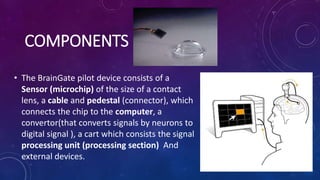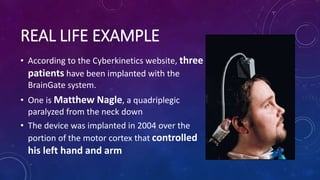Braingate by Mamta
- 1. SEMINAR BY: MAMTA (I.T. IVth YEAR) 0902IT131020
- 2. INTRODUCTION âĒ BrainGate is a brain implant system built, designed to help those who have lost control of their limbs, or other bodily functions, such as patients with Amyotrophic Lateral Sclerosis (ALS)[disease that causes the death of neurons which control voluntary muscles] or spinal cord injury. âĒ The sensor, which is implanted into the brain, monitors brain activity in the patient and converts the intention of the user into computer commands.
- 3. DEVELOPMENT BrainGate is developed by the bio-tech company CYBERKINETICS in 2003 in conjunction with the Department of Neuroscience at Brown University . BrainGate previously owned by Cyberkinetics , currently under development and in clinical trials and now owned by privately held BrainGate. In July 2009, a second clinical trial (dubbed "BrainGate2") was initiated by researchers at Massachusetts General Hospital, Brown University. Nicholas HatsopoulosJeff StibelJudy Hackett
- 4. UNDERLYING PRINCIPLE âThe principle of operation of the BrainGate Neural Interface System is that with intact brain function, neural signals are generated even though they are not sent to the arms, hands and legsâ. The signals are interpreted and transmitted into cursor movements.
- 5. NEUROCHIP âĒ The chip uses 100 hair-thin electrodes that 'hear' neurons firing in specific areas of the brain, for example, the area that controls arm movement. It is made of silicon. âĒ It sense electromagnetic signature of Neutrons.
- 6. IMPLANTING âĒ The chip is implanted on the surface of the brain in the motor cortex area that controls movement. Doctor drills a small hole into the skull and implant the sensor.
- 7. COMPONENTS âĒ The BrainGate pilot device consists of a Sensor (microchip) of the size of a contact lens, a cable and pedestal (connector), which connects the chip to the computer, a convertor(that converts signals by neurons to digital signal ), a cart which consists the signal processing unit (processing section) And external devices.
- 8. WORKING Monitored signal send by brain is translated into electrically charged signals, Signals are then sent and decoded using a program to move cursor, robot arm, even a wheelchair etc.
- 9. Invasive BCIs are implanted directly into the grey matter of the brain during neurosurgery . Invasive BCI provides the highest quality of signals among BCIs but are prone to scar âtissue build- ups. Partially invasive BCI devices are implanted inside the skull but rest outside the brain rather than within the grey matter. They produce better resolution signals than non-invasive BCIs where the bone tissue of the cranium deflects and deforms signals and have a lower risk of forming scar-tissue No break in the skin is made .Activities are carried out on the scalp. INVASIVE PARTIALLY INVASIVE NON-INVASIVE BRAIN-COMPUTER INTERFACE
- 10. REAL LIFE EXAMPLE âĒ According to the Cyberkinetics website, three patients have been implanted with the BrainGate system. âĒ One is Matthew Nagle, a quadriplegic paralyzed from the neck down âĒ The device was implanted in 2004 over the portion of the motor cortex that controlled his left hand and arm
- 11. MATTHEW NAGLE âĒ âI can't put it into words. It's justâI use my brain. I just thought it. I said, "Cursor go up to the top right." And it did, and now I can control it all over the screen. It will give me a sense of independence.â -- Matt Nagle âĒ Using the BrainGate system, Matt could control a : - Cursor on a computer screen - Control TV - Check e-mail - Draw on screen âĒ He could also send commands to an external prosthetic hand
- 12. ADVANTAGES AND APPLICATIONS âĒ Faster than what is possible with the hands of a non- disabled person. âĒ Controlling remote devices âĒ Making and receiving telephone calls âĒ Accessing the internet. âĒ Turn on or off the lights âĒ Control robotic arm âĒ Watch and control television âĒ Use the pc âĒ Locking or unlocking doors âĒ Motorized wheelchair âĒ Typing words by mind
- 13. DISADVANTAGES ïą Expensive ïą Risky Surgery ïą Not Wireless yet ïą Difficulty in adaptation and learning. ïą Limitation in information transform rate. The latest technology is 20 bits/min.
- 14. FUTURE SCOPE âĒ In the next two years, Cyberkinetics hopes to refine the chip to develop a wireless version âĒ No need for a plug âĒ Safer âĒ Less visible âĒ Smaller âĒ Wireless âĒ The user will have an improved control of respiratory system, limb with muscle stimulation or robotics.
- 15. CONCLUSION The invention of BrainGate is such a Revolution in medical field. The remarkable breakthrough offers hope that people who are paralyzed will one day be able to independently operate artificial limbs, computers or wheelchairs.

![INTRODUCTION
âĒ BrainGate is a brain implant system built, designed to
help those who have lost control of their limbs, or
other bodily functions, such as patients
with Amyotrophic Lateral Sclerosis (ALS)[disease that
causes the death of neurons which control voluntary
muscles] or spinal cord injury.
âĒ The sensor, which is implanted into the brain,
monitors brain activity in the patient and converts the
intention of the user into computer commands.](https://image.slidesharecdn.com/mamtabraingate-170803201223/85/Braingate-by-Mamta-2-320.jpg)













